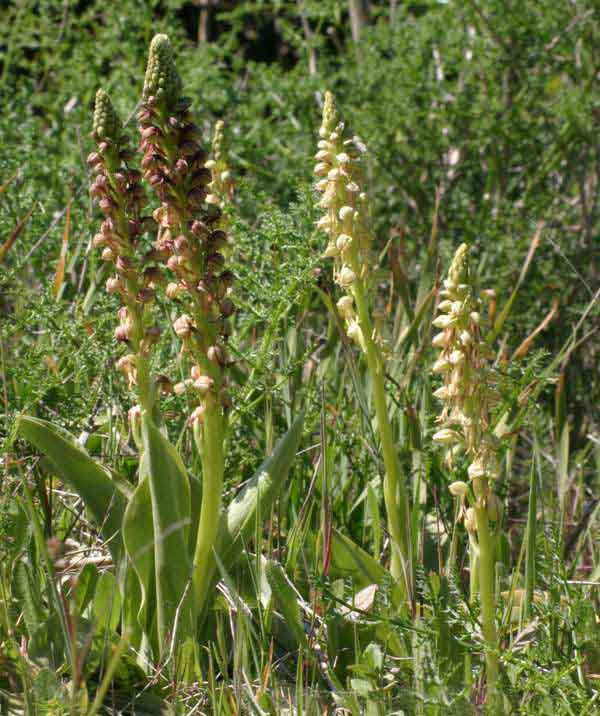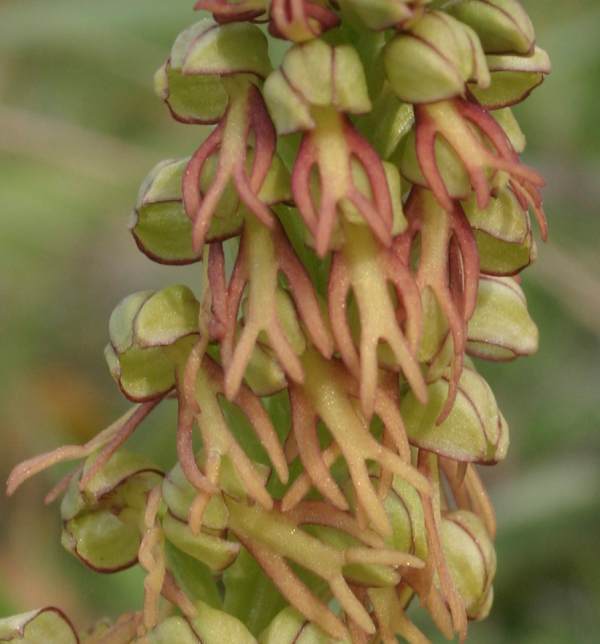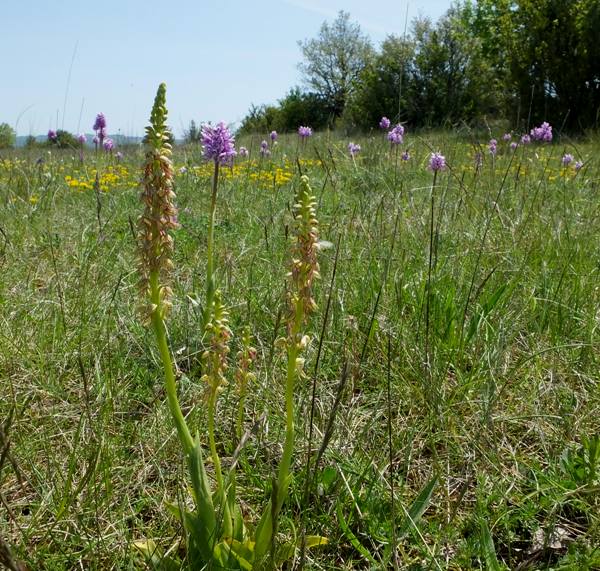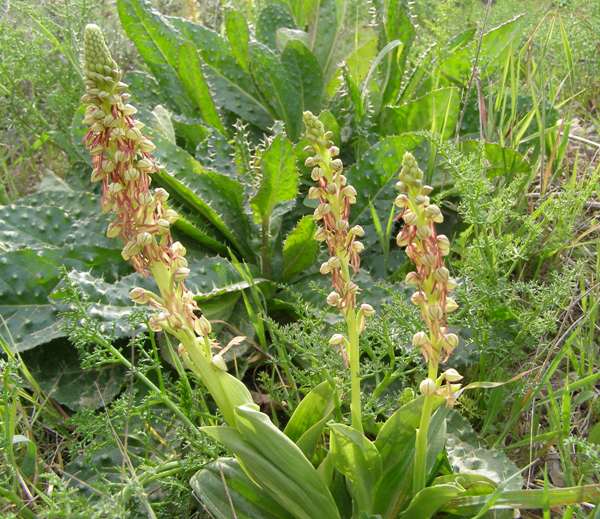Trees Birds Mammals Fish Amphibians Reptiles
Wild Algarve
Bookshop
Orchis anthropophora - Man Orchid
Phylum: Magnoliophyta - Class: Liliopsida - Order: Orchidales - Family: Orchidaceae

Although still rather common and widespread in the Mediterranean-Atlantic area of Europe (these specimens were photographed in Southern Portugal) the Man orchid is now extremely rare in the UK. Until recently this orchid was called Aceras anthropophorum, but recent molecular study has revealed the closeness of its relationship with members of the genus Orchis and has resulted in it being moved to that genus and now referred to as Orchis anthrophora.
Description
The name Man Orchid refers to the human shaped lip of the flower which, together with the sepals and petals which form a hood above the lip, gives the flower a strong resemblance to a small human figure. The plants grow to around 40cm tall and there are 5-10 basal leaves which are unmarked but clearly veined. The colour of the flowers varies from greenish-bronze to pale yellow and they are usually marked with bronze.

Distribution
The Man Orchid is widespread and common in the Mediterranean-Atlantic region of Europe and is found as far north as the UK and Germany and eastwards into central Europe, becoming rare further north and east.

Above: Man Orchids growing with Monkey Orchids, southern France
Habitat
This is an orchid of short alkaline grasslands and is most often found growing full sun or mid-shade, but the Man Orchid is also found occasionally along the edges of open woodland and in scrubby areas.
Flowering times
Orchis anthropophora can be seen in flower from the end of March (in southern Europe) to the end of June (further north).
The photographs shown on this page were taken in the Algarve in Portugal in early May. We have also photographed this wonderful orchid in Crete, the Gargano Peninsula in Italy and in the Lot Valley in France.

Subspecies
None recorded.
Varieties
Orchis anthropophora var. flavescens lacks red pigments and has a green hood and yellow lip.
Hybrids
Hybrids with Monkey, Lady and Military orchids are common in parts of European but rare in England.
Orchis x bergonii, the hybrid with the Monkey Orchid Orchis simia, which occurs on the European mainland, has been reported from England but may have been the result of a mistake with hand pollination.
Orchis x meilsheimeri, the hybrid with the Lady Orchid,occurs on the European mainland and was found in Kent in 1998, when two of these hybrid plants were seen.
Etymology
The genus name Orchis means 'testacles', a reference to the twin tubers of orchids in this genus. The specific epithet anthropophora means 'bearing men' - a reference to the human-like form of the flowers.
Reference sources
The Plant List
Sue Parker (2023) Wild Orchids of the Algarve - where, when and how to find them; First Nature e-book (Amazon Kindle format)
Chris Thorogood and Simon Hiscock (2014) Field Guide to the Wildflowers of the Algarve; Kew Publishing
Pierre Delforge (2005) Orchids of Europe, North Africa and the Middle East; A&C Black
Fielding, Turland and Mathew (2005) Flowers of Crete; Kew
Sue Parker's latest ebook is a revised and enlarged edition of Wild Orchids in The Burren. Full details here...
Buy it for just £5.95 on Amazon...
Sue Parker's new ebook is a comprehensive and fully revised edition of her acclaimed field guide to the Wild Orchids of Wales. Full details here...
Buy it for just £5.95 on Amazon...
Sue Parker's 5-star acclaimed field guide to the Wild Orchids of the Algarve is now available as an ebook. Full details here...
Buy it for just £5.95 on Amazon...
Please Help Us: If you have found this information interesting and useful, please consider helping to keep First Nature online by making a small donation towards the web hosting and internet costs.
Any donations over and above the essential running costs will help support the conservation work of Plantlife, the Rivers Trust and charitable botanic gardens - as do author royalties and publisher proceeds from books by Pat and Sue.